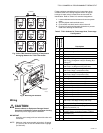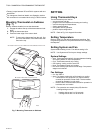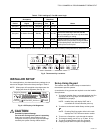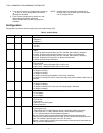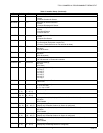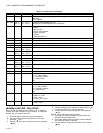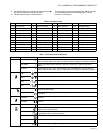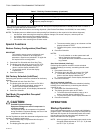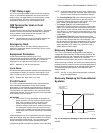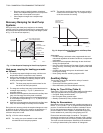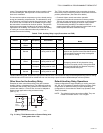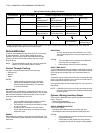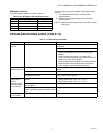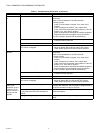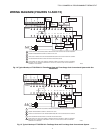
T7351 COMMERCIAL PROGRAMMABLE THERMOSTAT
15 63-2666—02
control. The potentiometer adjusts the minimum position of the
economizer dampers, which provide a minimum amount of
fresh air for ventilation.
The economizer reduces compressor run time, thereby saving
energy and extending compressor life. The drawback to using
the economizer is that during the Not Occupied period, if there
is no call for cool or outdoor air is not suitable for free cooling,
the economizer is controlled to minimum position. This position
allows some percentage of outdoor air to enter the building,
regardless of air suitability. The situation can cause the heating
or cooling to run more often than when only suitable air is
permitted to enter the building.
The T7351 can take advantage of an economizer by closing
the auxiliary relay contacts to control the economizer minimum
position potentiometer. (See Table 8 for details.)
— Powered: Allows normal economizer operation.
— Unpowered: Disables the economizer minimum position.
The lack of power causes the economizer to drive dampers
fully closed instead of staying at minimum open position.
This reduces the possibility of unsuitable outdoor air
entering the building, which lowers the internal load on the
HVAC system and saves additional energy.
a
Unless otherwise, noted, Economizer logic ignores calls for heat. The Economizer relay will be energized during calls for cooling.
b With fan set to AUTO and call for neither heat nor cool, the relay is open in order to disable damper minimum position.
Other Uses for the Auxiliary Relay
Examples of other uses of the auxiliary relay are hot water
heaters, lighting, or baseboard heat. The additional loads are
connected to the auxiliary relay contacts on the subbase. The
contacts are rated for 1.5A at 30 Vac, but can be adapted to
higher current applications using an external relay
(See Fig. 13).
Fig. 13. Using T7351 Models with an External Relay (with
loads greater than 1.5A).
Default Auxiliary Relay Operations
Unless configured as a stage of heating or cooling, terminals
W2, W3, and Y3 operate for specific auxiliary functions. Each
output takes on different auxiliary functions depending on
configuration for Conventional or Heat Pump operation. See
Table 9 for details.
NOTE: The default functions cannot be modified. They are
limited to firmware version 1.3.0 or higher.
Table 8. T7351 Auxiliary Relay Logic (Economizer and TOD)
Occupancy Auxiliary Contacts
Notes
Scheduled
Period
Motion Sensor
Signal
Effective
Occupancy Economizer TOD
Occupied No Sensor
Wired
Occupied
Closed
b
Closed
Occupied Motion Sensed Occupied
Closed
b
Closed
Occupied No Motion
Sensed
Standby Open; Closed only
during calls for cool
a
Open Effective Occupancy is Standby. Standby
setpoints are used and it assumes that the space
is unoccupied. Economizer relay is energized
only on calls for cooling.
Not Occupied No Sensor
Wired
Not
Occupied
Open; Closed only
during calls for cool
a
Open
Occupancy sensor will only be active during
scheduled Occupied periods. During scheduled
Not Occupied periods, the effective occupancy
will always be Not Occupied.
Not Occupied Motion Sensed Not
Occupied
Open; Closed only
during calls for cool
a
Open
Not Occupied No Motion
Sensed
Not
Occupied
Open; Closed only
during calls for cool
a
Open
M19613
1
1
RELAY REQUIRED (R8222 OR SIMILAR).
T7350A,B,D,M SUBBASE
TO
LOAD
AUXILIARY
RELAY
CONTACT
AUX
RH
X



